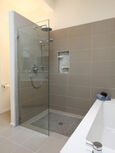This week we presented the back-brief, which is essentially what we have decided to do for our project and what the component tasks need to be done to complete it.
Back Brief Outline
- Group Name: Geriambiance
- Group Members:
- Steven Best (leader)
- Dan Zhang (Dan)
- Jing Liu (Laura)
- Mathew Kruik
- Siyan Li (Allen)
- Group Project: Livable Bathrooms
Project Conditions
- Project Concept:
This project aims to create a series of smart and convenient bathroom appliances and fixtures, designed for ease of use for elderly people. A Kinect for Windows will be situated in a corner of a bathroom in order to track resident’s movement and body reactions, allowing it to adjust bathroom devices intelligently. The height and conditions of furniture and equipment can be controlled by residents’ gestures to help with their everyday bathroom activities which could be hindered by a lack of movement.
- Project Proposal:
In the project, a series of bathrooms will be designed and imported into CryEngine 3, a video game engine. This will be linked to a Microsoft Kinect for Windows, a motion tracking device, which allows a person to move around in a real world space and control the in game character. This allows a demonstration of how the Kinect allows the control of real world appliances and fixtures through gesture control.
- Specific Intelligent Equipment:
- Door:
- Open - When residents stand in front of and face the door, the door will automatically open.
- Close/lock - When residents enter the room, the door will automatically close and can lock with the use of a specific gesture.
- Light:
- Main light – open/close: When residents enter or leave the bathroom, the main lights will turn on or off accordingly
- Mirror light – open/close: When residents enter or leave the area occupied by the mirror, lights around the mirror turn on and off accordingly. Gesture control allows for the dimming and brightening of these lights.
- Shower light – open/close: When residents enter or leave the shower area, shower light will automatically turn on and turn off accordingly.
- Sink:
- Turn on – When users put their hands under the tap, the tap will turn on.
- Turn off – When users move their hands away, the tap will turn off.
- Up – When users lift up their palms, the water pressure increases.
- Down – When users move their hands down, the water pressure decreases.
- Shower:
- Tracking – When a resident turns the shower on, the Kinect knows where their body is in relation to the shower head, and will move the shower head to be in the right position for the body, both in height and sideways movement.
- Temperature:
- Up – When users lift up their palms in the shower, the water temperature increases.
- Down – When users move their hands down in the shower, the water temperature decreases.
- Toilet:
- Positioning – When a resident enters the bathroom, the Kinect reads their body height and adjusts the height of the toilet to best suit their needs for sitting down.
- Flushing – When residents stand up from the toilet, the toilet will start flush automatically.
- Ventilation:
- Turn on/off - When residents enter the space, the exhaust fan will turn on intelligently and when they are out of the space, the exhaust fan will turn off automatically.
- Safety
- Collapse Detection - The Kinect can detect when a user falls down and can alert relevant persons to assist.
- Door:
Project Planning
- Bathroom Design
- Designers: Dan Zhang (Dan), Jing Liu (Laura), Siyan Li (Allen)
- Design Proposal: Design a series of three bathrooms, containing all the devices to simulate a real world space. After modelling the bathrooms, this 3D space will be imported to CryEngine 3, where it will be hooked up to the Kinect. These bathrooms will encompass all of the fixtures and devices used by the elderly, including those that assist them with disabilities.
- Design Scales: 3x2m, 3x4m, 4x6m.
- Design Concepts:
Sink Design: Embeded in timber frame floor / Easy to adjust height
Toilet Design: Regular height / Within steel column to adjust height
Shower Area: Seperated by glass/ protect privacy
Bath Tub Design: Build in / Easy to get in for elders
- Programming
- Programmers: Steven Best, Matthew Kruik.
- Programming Concept:
- Connecting the Microsoft Kinect to a computer, the data is read by the node system in CryEngine 3, allowing full control of the character, and interaction with the virtual space.
- Additionally, an Arduino kit will be used to allow the Kinect system to track the user, negating it's small range and limited movement.
- Test Proposal:
- Outlining an area in a room that equates to our virtual space, the sensor is located in the same position it is in the game engine. A series of boxes are setup throughout the space, mimicking fixtures such as toilets and sink. A user is able to walk through the space and see onscreen how the virtual appliances and fixtures react to them.
- To take this one step further, we will look into virtual reality devices such as the Occulus Rift, which would allow a much more immersive experience.
All this information was posted on our wiki to provide a common area for our members to communicate. The wiki will be used to document progress and provide reference for each project member to ensure a cohesive project is delivered.




No comments:
Post a Comment